Bigfoot 200
2019 Bigfoot 200.
Race report: What a weird, fun, painful, amazing experience. 206 miles and 42,000 ft of elevation gain, over ~58 continuous hours running ultra and beyond through the Cascade Mountains...
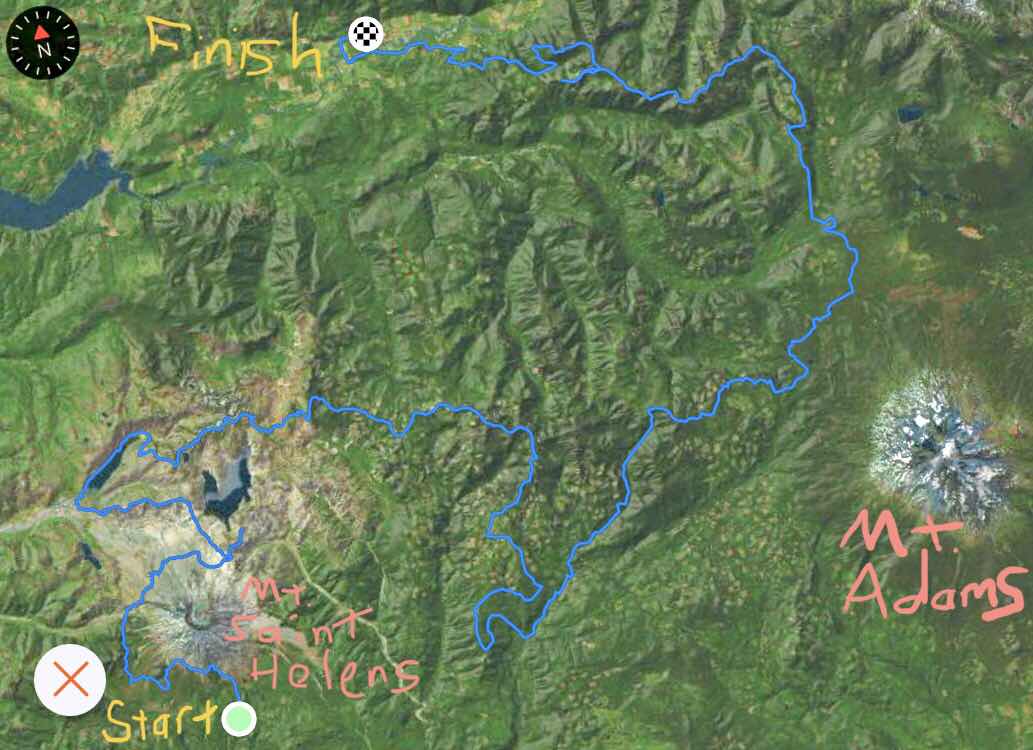
The route. Doesn’t seem like it’d be too hard from this picture!

Timely sign that we saw in Pike Place Market in Seattle

Just some runners making their way along a volcano ridge, 6 miles into a 206-mile race - nbd
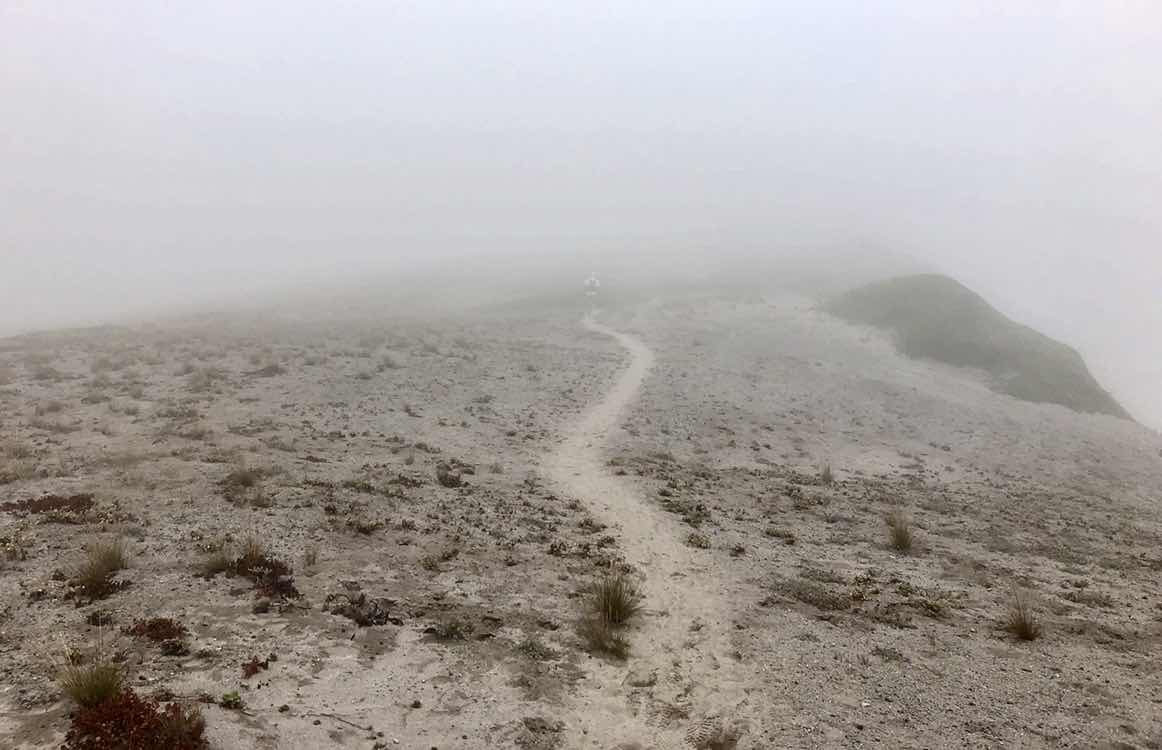
Some of the higher-elevation sections of the volcano were otherworldly, especially inside the clouds

Windy Ridge, mile 30 (PC: Julie!)

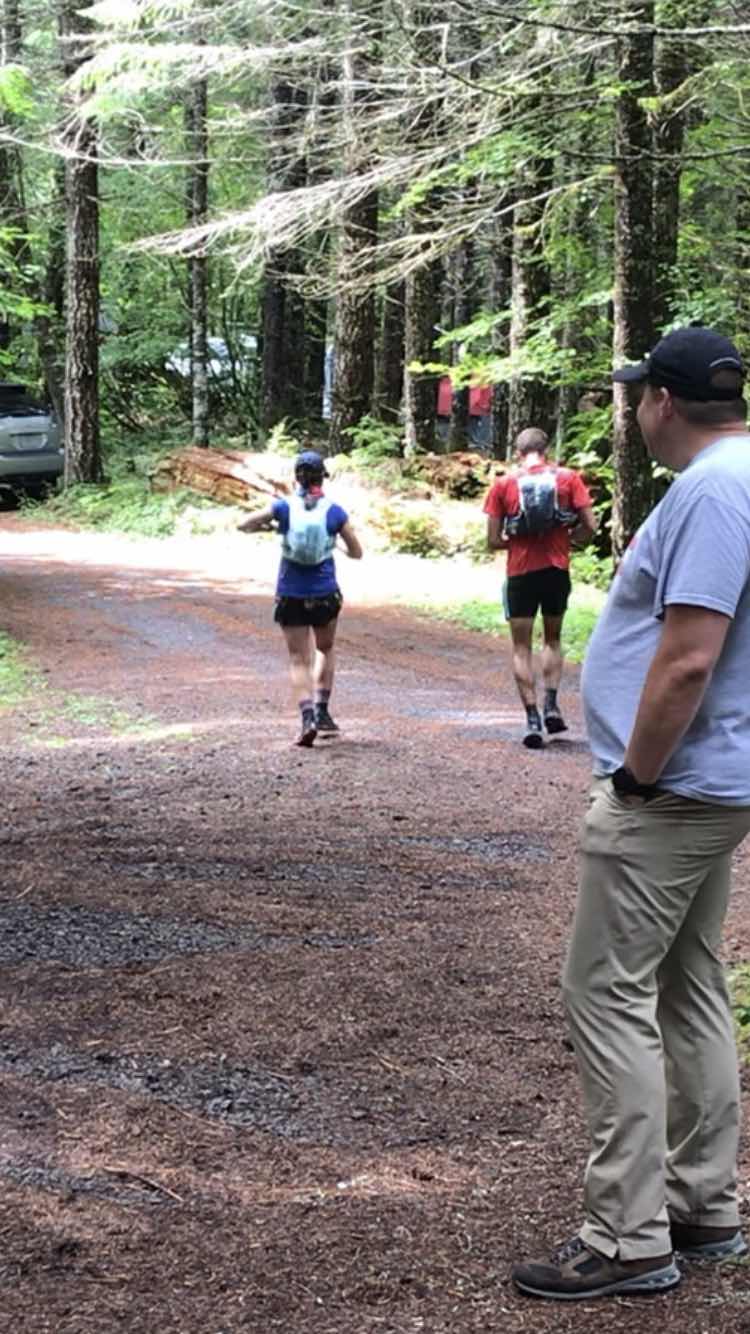
Leaving Lewis River (mile 112)
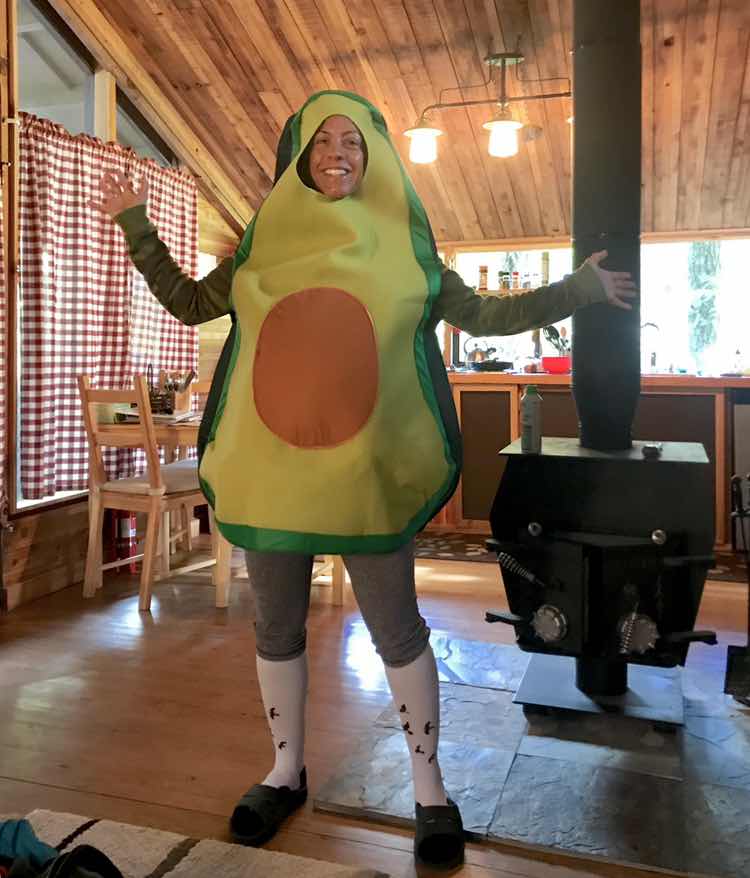
Oh yeah, she also was an avocado!

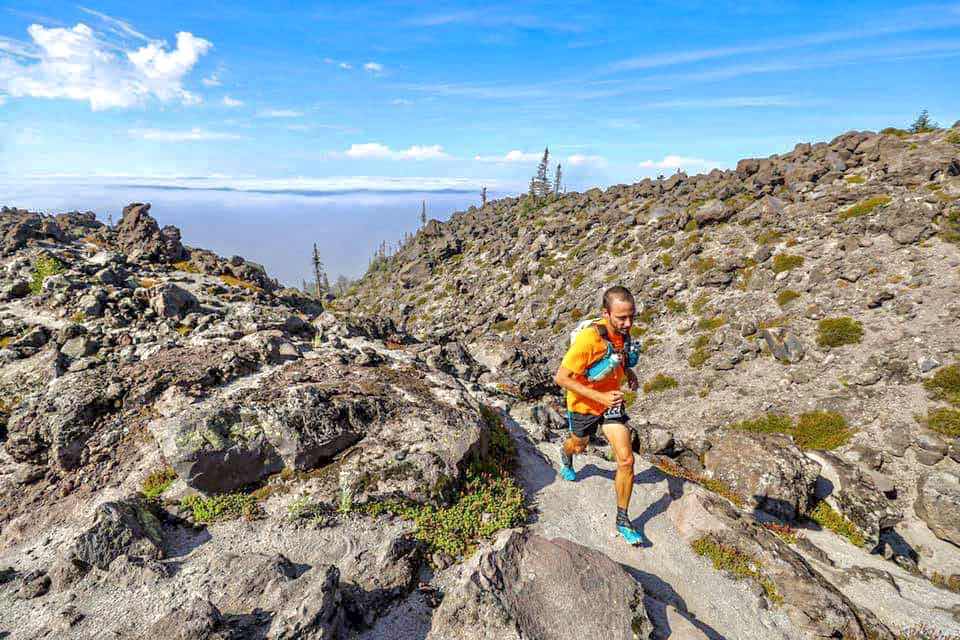

200 miles later..
Race report: What a weird, fun, painful, amazing experience. 206 miles and 42,000 ft of elevation gain, over ~58 continuous hours running ultra and beyond through the Cascade Mountains...
I’ve been trying to get back into more competitive running this year, and wanted one big target race in late summer or fall, so I’d have something to work towards in 2019 as I got back into shape. One at a time, I applied for 5 different, relatively popular northwestern / mountain-area 100-mile races. Because of often remote locations and lack of infrastructure, the bigger trail ultras have to impose caps on field size (~100-400 runners, as opposed to popular road marathons in big cities that can accept 20,000+), so registration is often some variety of lottery process for the higher-demand ultras. And one-by-one, I had to cross all 5 off my list (mostly lotto rejections). The 6th race I considered was not a 100-miler, but the Destination Trail Bigfoot 200-miler in WA (actually, ~206 miles). Bigfoot’s registration had been open this whole time, and only 175 of the 200 allotted spots were taken when I looked.
I’ve only completed the 100-mile ultra distance twice, both times were in 2017. The first experience was running alongside Julie every step of the way - the Bighorn 100 in Wyoming (race report). A few months later, I raced one myself (Cactus Rose race report) in Texas, and that 100-miler took me ~18 hours (including 2 additional bonus ‘trailblindness miles’). I looked up the Bigfoot 200 course record and it was about triple the amount of time it took me to run Cactus 100, so I had no concept of what to expect from my body. From my limited experience in pacing and crewing others in a couple different 200-milers, it seemed like an entirely different sport than 100-mile-and-below ultras. This new 200-mile ‘sport’ just seemed to be nothing but days of continual misery for people like Julie (Tahoe 200 race report), Erin (Franklin 200 race report), and a few other weirdo friends we have that knowingly sign up for such pain. Weirdos.
So .. yadda yadda yadda .. I signed up for it too, fairly recently after swearing I’d never do anything that dumb.
Here’s how it works. The starting line clock starts at 9am Friday and we all run into the forest together. You have a maximum of ~4+ days to get to the finish line; you just have to take the race’s specific course of remote trails through the mountains, and stop at all their check-in aid stations. They track you, mostly for safety purposes, with a GPS position transmitter that each racer carries; the device works properly at random/intermittent times for fractions of the race (a smaller fraction in dense forest), and then you give it back after crossing the finish line.
The route. Doesn’t seem like it’d be too hard from this picture!
I knew to expect the unexpected, but that’s about it. I worked up a 60-hour pace chart, mostly for Julie to use for planning and adjusting her arrivals at aid stations, but in reality we both knew it could possibly take much, much longer, due to all the unknowns and surprises that show up in a race this long. Actually, in the 5 years of the race’s existence, only two people had ever finished it in 60 hours or less, prior to 2019. It was hard for me to think of what could possibly happen that could make me take longer than 60 hours, but I’d soon find out about all those different surprises that can occur!
Timely sign that we saw in Pike Place Market in Seattle
For me it’s all about learning lessons and getting better. When I succeed at things, yes, I do get to learn what works, but I always learn 10 times more from failing; there were definitely plenty of those learnings this weekend!
The first day out there was probably the most scenic for me, looping around Mount Saint Helens, and up some ridgelines with great views of the volcano and several lakes. There were many other mountain summits / vistas along the entire 200-mile course, but after that first day, I always seemed to be at the more scenic places at night.
In this race I actually took pictures with my phone during the run, which I think is a first for me!
Just some runners making their way along a volcano ridge, 6 miles into a 206-mile race - nbd
Some of the higher-elevation sections of the volcano were otherworldly, especially inside the clouds
Competition-wise, I’d basically see the same 3 guys - Mike, Jesse, and Gena - over and over. Actually, the four of us (especially me, Mike, and Gena) seemed to leapfrog back and forth for most of the race.
I was all alone in the lead for a good 35-mile stretch on day one (miles 28-63), even arriving to a couple aid stations prior to when the volunteers were told the first 200-milers could potentially start arriving.
Windy Ridge, mile 30 (PC: Julie!)
Let’s just say, lots of things happened over the 58+ hour race. Lots. But to avoid making this post ridiculously long, I’ll focus only on a few key sections of the race from here, and certain other things that stand out.
**********
Norway Pass
The most significant leg of day one for me was from Coldwater Lake aid (mile 46) to Norway Pass aid (mile 65); this 19-mile section had ~5100’ of climbing (for reference, I generally get only ~500’ climbing over the same distance in San Antonio). This segment was also generally where the race stopped being normal, and slowly started phasing into totally crazy.
As I begrudgingly tried to power-hike up the endless trail to Mt. Margaret, the highest-elevation point on the course, it was starting to get dark. The previously-distant thunderstorm clouds were now getting closer. My eyes were getting heavier from not getting nearly enough sleep the night before (I was too excited!). And I forgot to eat anything for a really long stretch going up the pass.
All of a sudden I got weak and wobbly, and immediately kicked myself for forgetting about something I was trying to be laser-focused on: eating constantly. I pounded some gels and kept climbing (obviously much slower now), apparently right into the t-storm clouds. I summited Mt. Margaret and it was now too dark to safely run down, so I turned on my headlamp, only to have the cloud mist, inches in front, reflecting light back at me - not really helping me see the trail too well. Then the big thunderstorm seemingly decided to give me a big hug. This experience was definitely a first for me: being inside a thunderstorm cloud while it generates lightning all around. Every lightning strike immediately washed my vision out with surrounding white light, which occurred simultaneously with a cracking sound louder than anything I could’ve imagined; my natural reaction and process, every time, was just to hit the dirt, prone (trying to dodge lightning?), mutter something to myself about how idiotic this was, then pick myself up and shuffle along. Finally there was a half-second sound delay after the flashes, then one second, and I knew at least it wasn’t centered on top of me anymore.
But then it started pouring rain, and didn’t stop all night. More forgetting to eat, followed by woozy staggering. Every time I stopped to walk, it was like my eyelids couldn’t stay open. I stopped to lay down in the dirt several times, in the hopes a short nap would power me a mile or two closer to Norway Pass aid. I was marginally successful in a few of those attempts, but without moving around, the cold rain quickly dropped my body temperature and I was always rustled up within 5 minutes, shivering. I stopped to sit and rest a lot, also a first for me; I mean, it’s a race but it didn’t stop me from taking maybe 15-20 little sit-and-rest breaks. Why were things spiraling down so quickly?
I knew I was having my first major “low point” and, logically, I knew I could get past it (I’d overcome these before in previous ultras). But it did not stop me from dreaming about quitting, and thinking of good excuses to do so. I went so far as to mentally hatch a scheme in which I’d get “lost” and go off-course for a few miles, then retrace my steps and just ask a volunteer to drive me back. I was still leading the race, for crying out loud - what was wrong with me? This would just be the first of many illustrations of how extreme the manic “ups-and-downs” curve is for a 200. I’m on top of the world (up). I wish I was dead (down). I’m on top of the world. I wish I was dead.
With only 2-3 miles left on this leg from hell, I slipped on a slippery, narrow ledge and fell off a damn cliff. I still don’t know for sure how exposed it was and what was down there, due to darkness and clouds, but I managed to claw my arms deep enough into some mud after sliding down about a body length (which felt more like a hundred feet!). After a few slippery/scary failed attempts to climb back up to the trail, I finally shimmied over to some more stable rocks that helped me climb up and pull my mud-logged body back over the cliff. Just then, as I was laying there on the trail, I saw a headlight coming (turned out to be Gena), and I immediately warned him to be extremely careful right there, as I just spent the last 5 minutes trying to crawl up. He said “thanks” and forged right ahead, taking over 1st place. I honestly could not have cared less in that moment!
Bigfoot Aid Station Volunteers
Then I finally got to Norway Pass at ~10:15 pm, more than 5 hours after leaving Coldwater, and the aid station volunteers completely turned me around. I arrived starving, again (a common mistake that I continually refuse to learn from), and they just kept suggesting, and then bringing, food to me. Like, a lot of food - I said yes to everything. They asked me questions and talked to me until the light finally started to return to my eyes. This experience repeated itself throughout the entire weekend - completely selfless Bigfoot volunteers working in tents at all hours of the night, in the middle of nowhere (often requiring 2+ hour drives on terrible, muddy, rutted forest service roads), in 48-degree, pouring rain conditions, just so they can help racers get through this ridiculous pursuit. Two of them even friended me on Instagram already! Looking back at the whole experience now, I have to say this that arriving and hanging out at aid stations, and my interactions / time with the volunteers during the 2019 race, easily beats out memories of beautiful scenery, or any post-race feelings of accomplishment.
There are countless other examples just from my own race experience, but so much is blurred together in my fogged-up mind. Spencer Butte aid really lifted my spirits after a tough leg, then kindly scooted me along when I lingered too long. Lewis aid station brought extra food so they could feed runners’ crews, including Julie. Klickitat volunteers took off my nasty socks for me, and helped clean up my nauseating trench-footy feet so I could change shoes!
**********
Erin
This extremely kind soul, fellow 200-mile-running-weirdo, and good friend of ours woke up at 4am on a Saturday, so that she could make a long drive from Idaho to accompany me through some of the toughest forest segments in the second half of the race. This was huge, as Julie is now in month 7 of pregnancy and obviously wasn’t going to be able to jump in as a pacer.
Knowing I enjoy an occasional bacon binge every now and then, here’s how she showed up at the Lewis River aid station (mile 112).
The volunteers immediately started cooking bacon for everyone
She then very quickly morphed from Bacon Erin into Trail Runner Erin, and we took off on a 19-mile overgrown, bushwhacking leg through wet, dense forest that had ~5500’ of climbing. This leg (Lewis River to Council Bluff) was the steepest of the course (vert/mile), had the most overall vertical gain, and I can’t think of a single redeeming quality about it. I complained, a lot. Poor Erin! Climbing is also my weakness (why did I pick this race again?), so even though I was leading the race again as we took off, I knew it was only a matter of time before people were going to catch back up. Sure enough, Gena only needed a few miles and then it was (Mountain) Mike, a while later. I hate to think how bad it would’ve been without Erin - we had great conversations that allowed me to temporarily stop thinking about how much I wanted to curl up and just die right there in the forest. I was even able to (more or less) stick with Mike once he passed us towards the end of the segment.
Leaving Lewis River (mile 112)
She jumped in again the next morning to take me through the last ~30 miles. She probably didn’t expect to help in this particular way, but she was able to dispel many of the hallucinations I was seeing at the end. Erin also reminded me to eat, something I proved incapable of remembering to do when left to my own devices (see next section). Having her there for the last two segments also motivated me to push past my inherent laziness at the end, and run hard, as we both thought 2nd place was still within reach at the time. The way we ran through much of the remaining dirt trails (dropping 10-min miles that felt like 6’s!), I am 100% confident I emptied my tank, and that is thanks to her.
Oh yeah, she also was an avocado!
*******
Spiraling Down - Hallucinations and Stuff!
This is the gruesome part of the story that you really came to see. Like those people that slow you down on the interstate so they can get a good look at the accident on the opposite side of the highway, hoping to get a glimpse of a mangled car, or body bag or whatever. Well read on, sickos!
Chain of Lakes to Klickitat
When Erin and I reached Council Bluff aid in 3rd place at mile 131, Julie tried to convince me to sleep a little, given that I’d been moving for 34-35 hours straight with only a few 5-minute naps. It was still light outside though, so I knew it probably wouldn’t happen there, but the next aid at mile 141 (Chain of Lakes) had a sleep station and it’d probably be dark by then. I could sleep there.
Competition-wise, Mike and I were a couple minutes apart coming into Council Bluff; Gena was in the lead, but I hadn’t seen him for a few aid stations now. Mike and I took off from Council Bluff for Chain of Lakes at about the same time, ran a few good portions of that segment together, and I could tell we were making pretty good time - I was thankfully on an ‘up’ portion of my ups-and-downs curve again, and feeling strong.
When we arrived at Chain of Lakes, Gena was still there, and packing up to leave for Klickitat. It seemed like that was enough for Mike to cut his stay short too, and they both were quickly bustling around, grabbing food and stuff. This disappointed me on several levels! While part of me was happy that we (top-3 at the time) were all right there together, I knew this next segment was long and brutal, and I really just wanted to reset and relax with everyone at the aid station. Plus, I was supposed to sleep here, which was clearly off the table now; just try to fall asleep while 1st and 2nd place are running off, getting farther ahead of you - yeah, no problem.. I only half-jokingly suggested that we all just needed to chill out awhile and hang out in the nice chairs, but only the volunteers seemed to think that was a good plan. The two competitors seemed pretty intense.
Ok fine, plan B: I’ll take a caffeine pill, grab copious amounts of food, and leave a couple minutes after them, running my own pace. Maybe they’ll push each other too hard, and I can just plod through their carnage later (it never works out quite like you dream up).
Roughly 1 (one) mile into this 17+ mile segment, I stepped funny on something coming down an annoying rutted downhill, and my entire right foot popped out of the side of my (new) Hoka Cliftons. The upper mesh completely ripped away, from the front of the toe box all the way down to the left side of my heel. After stopping to confirm that, yes, that $&!# really did just happen, I just decided to keep going. One step later, I fell down as my foot popped out again, and I started working on re-lace strategies, trying to hold the upper and lower together with the shoelace. It never held up for more than a minute of running, so I focused on how to adjust my stride to cover the next 16 miles in my new Flappy reality. I did figure out a weird tiptoe-galloping way to “run” that mostly kept my foot inside the shoe, but it only worked when there was flat or slightly uphill terrain.
Somehow I actually passed and stayed ahead of Gena, who appeared to be on a ‘down’ curve and struggling hard. I even temporarily passed Mike about halfway through the segment (maybe mile ~150) after a nice, longer flat portion. But that would be the last time I’d ever lead this race again - Mike quickly caught me during another of my calorie bonks, and then put an enormous gap on me in just the last few miles of the segment, as the course required a summit of the incredibly-steep-and-slippery Elk mountain. Even worse with Flappy Shoe was descending it. Downhill is typically an advantage for me, but Flappy made it impossible. Looking at the GPS data, it took me over an hour to crawl down the last 1-1.5 miles. That’s because all I could come up with to make it down safely, was a backwards (facing the mountain) hands-and-feet crawl. Mountain Mike was long gone by the time I crawled into Klickitat aid, and he only got stronger from there, eventually beating the old course record by 4 hours! It was comforting when I heard that - he would’ve destroyed the entire field no matter what!
Klickitat to Twin Sisters
By pure luck, my one drop bag that had a pair of shoes in it, was at Klickitat. With 2 good shoes on my 2 feet, I begrudgingly left the friendly aid station volunteers and started a 19.4-mile journey to Twin Sisters aid (mile 177). I was on an ‘up’ once I got going though, and still ran with the intent to close the gap on Mike, knowing I’d probably see Julie at the next aid station and get Erin back as a pacer for the last 2 segments in the morning. Plus, the terrain coming up after Twin Sisters was much more gentle and favored my Texas flatlander legs.
Unfortunately, much of that last solo segment (while very well marked with ribbons) had either no trail or an overgrown/buried trail, bad footing, all kinds of obstacles to crawl around, and very few opportunities to even run at all. I definitely should have been more conservative and brought more food than I did, but I also was not expecting 19 miles to ever take me 9 hours. I, uh, started to calorie bonk again with 6 miles remaining, and, uh, had no food left in my pack.
This is where it gets weird. Approaching the 48-hour mark in the race, I doubt I’d slept more than 10 or 15 minutes the whole time. And I was STARVING! Wobbly, light-headed, and starting to see and hear things, my pace got about 3 times slower (think old lady with a walker speed). I couldn’t remember for sure, but I thought there would be wild berries along this trail - I got weirdly obsessed with finding them, thinking maybe I could fuel up 2 calories at a time or whatever.
But there were no berries yet. There were flowers. I started looking closely at the leaves for consumption, trying to remember any tidbits from the Air Force’s survival course I had to take 15 years ago, but my IQ had probably already been reduced to single digits at this point, and I could not focus. Instead, I started to gather flowers for a bouquet for Julie. Several times, I completely forgot I was even in a race. Then I’d remember why I was in this forest, and that Julie and Erin were probably getting worried about me, and try to make better forward progress. Then I’d see a new flower that was not yet in my bouquet, and the cycle would repeat.
Then I started seeing berries! Huckleberries and blueberries. Somewhere I must’ve dropped the bouquet (which Erin actually spotted on the way back out!), and I stopped at every possible bush to pick berries instead. I must’ve eaten over a hundred, seemingly with little to no positive effect. I was still out of my mind, and now my tongue was numb. What did I eat? I don’t even remember.
Somehow, I made it to the aid station. Looking at the data - the last 6 miles of that segment took me 4 hours. That’s 1.5 mph, or a 40 minute-per-mile pace. I don’t remember the terrain that well, but I believe that was a relatively gentle section! What was I doing? I only have flashes of memories from it, and barely remember the aid station at all, except that I couldn’t talk to people because my entire tongue was numb. The food at Twin Sisters must’ve somewhat brought me back to reality, because my memory strengthens from there. But without getting sleep I was still swerving all over the trail for the rest of the race. Fortunately for my safety, Erin was pacing again!
As day three started, the hallucinations picked up significantly, and I must’ve seen a hundred different people, animals, etc. up ahead that ended up not actually existing once I got closer. Erin and I made a deal that she would just tell me if she saw another human, so I could just ignore whatever was off in the distance.
Finish and Aftermath
The last 9-10 miles are on road. We made a valiant attempt to catch Gena for 2nd place in those last 2 sections, but he was really fast at the end and we never saw him. Instead, we saw Jesse coming up behind us! I’d forgotten about him but he was moving really well, and there was absolutely nothing I could do about it, but just let him know 2nd place was also right up there (little did I know he was probably a bit too far ahead at that point).
That was it. Erin and I walked for the last 7-ish miles (which was about my running speed anyway), including the last portion on the high school track, where Julie accompanied us. A little girl ran over and told me I should go faster - she was probably right.
“Sorry, I can’t run anymore!”
I could only laugh at myself, for somehow ending up in 4th at the very end - I wasn’t even mad. It was just such a crazy race, and I got to experience a lot of new things.
Feeling strong in the first leg of the race
200 miles later..
One minute I’m having an out-of-body experience while lackadaisically picking flowers in the forest, and the next minute I’m focused on running strong to compete for the podium. One minute I feel like I could run forever and was born to run 200-milers, and the next minute I am getting rained on while laying in the dirt with one shoe on and wondering how to get myself down from a mountain. The highs and lows were just soooo extreme, and I know everyone had them too, because you could see it.
I’m not going to say that I’ll never do another Bigfoot or 200-mile race, because there is a lot of low-hanging fruit there. Just this weekend, a couple of very minor corrections would’ve easily saved hours and hours off my time. But it feels unlikely to happen anytime soon - first I’m not sure how many more of those I could even survive, but also because the event ends up being quite a long disruption to life in general!
Thanks to Julie, Erin, and everyone who encouraged me and gave me advice!
Amazing report of an incredible experience! Thanks a lot for sharing - great read! I am going to forward it to Megan Janssen in Trail Runner Magazine.
ReplyDeleteWow, amazing report indeed. Thanks for sharing your experience in so much detail.
ReplyDeletefree youtube video downloader
ReplyDelete